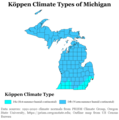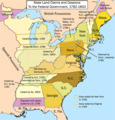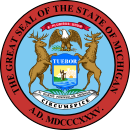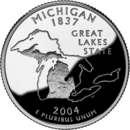The Michigan Portal  Michigan (/ˈmɪʃɪɡən/ ⓘ MISH-ig-ən) is a state in the Great Lakes region of the Upper Midwest region of the United States. It borders Wisconsin to the northwest in the Upper Peninsula, and Indiana and Ohio to the south in the Lower Peninsula; it is also connected by Lakes Superior, Michigan, Huron, and Erie to Minnesota and Illinois, and the Canadian province of Ontario. With a population of nearly 10.12 million and an area of 96,716 sq mi (250,490 km2), Michigan is the 10th-largest state by population, the 11th-largest by area, and the largest by area east of the Mississippi River. Its capital is Lansing, and its largest city is Detroit. Metro Detroit is among the nation's most populous and largest metropolitan economies. The name derives from a gallicized variant of the original Ojibwe word ᒥᓯᑲᒥ (mishigami), meaning "large water" or "large lake". Michigan consists of two peninsulas. The Lower Peninsula resembles the shape of a mitten, and comprises a majority of the state's land area. The Upper Peninsula (often called "the U.P.") is separated from the Lower Peninsula by the Straits of Mackinac, a five-mile (8 km) channel that joins Lake Huron to Lake Michigan. The Mackinac Bridge connects the peninsulas. Michigan has the longest freshwater coastline of any political subdivision in the United States, being bordered by four of the five Great Lakes and Lake St. Clair. It also has 64,980 inland lakes and ponds. Michigan has the second-most water area of any state, behind only Alaska. The area was first occupied by a succession of Native American tribes over thousands of years. In the 17th century, French explorers claimed it as part of the New France colony, when it was largely inhabited by Indigenous peoples. French and Canadian traders and settlers, Métis, and others migrated to the area, settling largely along the waterways. After France's defeat in the French and Indian War in 1762, the region came under British rule. Britain ceded the territory to the newly independent United States after its defeat in the American Revolutionary War. The area was part of the larger Northwest Territory until 1800, when western Michigan became part of the Indiana Territory. Michigan Territory was formed in 1805, but some of the northern border with Canada was not agreed upon until after the War of 1812. Michigan was admitted into the Union in 1837 as the 26th state, a free one. It soon became an important center of industry and trade in the Great Lakes region, attracting immigrants in the late 19th and early 20th centuries from many European countries. Immigrants from Finland, Macedonia, and the Netherlands were especially numerous. Migration from Appalachia and of Black Southerners as part of the Great Migration increased in the 1930s, with many settling in Metro Detroit. Although Michigan has developed a diverse economy, in the early 20th century it became widely known as the center of the U.S. automotive industry, which developed as a major national economic force. It is home to the country's three major automobile companies (whose headquarters are all in Metro Detroit). Once exploited for logging and mining, today the sparsely populated Upper Peninsula is important for tourism because of its abundance of natural resources. The Lower Peninsula is a center of manufacturing, forestry, agriculture, services, and high-tech industry. (Full article...) Entries here consist of Good and Featured articles, which meet a core set of high editorial standards.
The White Stripes were an American rock duo formed in Detroit, Michigan, in 1997. The group consisted of Jack White (guitar, keyboards, piano, and vocals) and Meg White (drums, percussion, and vocals). They were a leading group of the 2000s indie rock and garage rock revival. Beginning in the late 1990s, the White Stripes sought success within the Detroit music scene, releasing six singles and two studio albums, their self-titled debut album (1999) and De Stijl (2000). They rose to prominence with their critically acclaimed albums White Blood Cells (2001) and Elephant (2003), which propelled them to the forefront of the garage rock revival scene. The single "Seven Nation Army", which used a guitar and an octave pedal to create the opening riff, became one of their most recognizable songs. The band released two more albums, Get Behind Me Satan (2005) and Icky Thump (2007), and the documentary Under Great White Northern Lights (2009), before dissolving in 2011 after a lengthy hiatus from performing and recording. (Full article...)Selected picture - The Detroit Zoo is located about 2 miles (3.2 km) north of the Detroit city limits at the intersection of Woodward Avenue, 10 Mile Road, and 696 in Royal Oak and Huntington Woods, Michigan, USA. Did you know -
Related portalsSelected article - Presque Isle County (/ˈprɛskiːl/ PRESK-eel) is a county in the Lower Peninsula of the U.S. state of Michigan. As of the 2020 census, the population was 12,982. The county seat is Rogers City. The county was authorized by state legislative action on April 1, 1840, but the county government was not established until 1871. The government was reorganized in 1875. The name is an anglicisation of the French word presqu'île or presque-isle, which means a peninsula, or literally, "almost an island". A large part of Presque Isle Township consists of that peninsula, with Lake Huron on the east, Grand Lake on the west, and narrow strips of land connecting it to the mainland at the north and south ends. The community of Presque Isle is near the center of this peninsula. (Full article...)Selected biography -Thomas Wilcher is a college football administrator for Michigan State University and former high school athletic coach and teacher as well as a former National Collegiate Athletic Association (NCAA) Division I track and field and college football athlete for the University of Michigan. He was the NCAA Division I Men's Indoor Track and Field Championships national champion in the indoor 55 m hurdles and a three-time NCAA All-American in track and field (once indoor and twice outdoor). Wilcher was also a running back for the Michigan Wolverines football team from 1983–1986. In his redshirt senior year, he was a member of the Big Ten Conference football champion team as well as a 110 m hurdles Big Ten individual champion. Wilcher was a 9th round selection (226th overall) by the San Diego Chargers in the 1987 NFL Draft. In high school, Wilcher was a Michigan High School Athletic Association (MHSAA) record-setting hurdler and four-time All-American. As an athlete, he is a ten-time MHSAA track and field champion and a two-time Michigan High School Track and Cross Country Athlete of the Year award winner. He was also a Junior Olympics champion in the 110 m hurdles and an All-state and All-American tailback in football. He was also an All-City swimmer. (Full article...)General imagesThe following are images from various Michigan-related articles on Wikipedia.
TopicsCategoriesSymbols
Lists
Related pagesWikimediaThe following Wikimedia Foundation sister projects provide more on this subject:
Things you can doDiscover Wikipedia using portals | ||||||||||||||||||||||||||||||||||||








































































